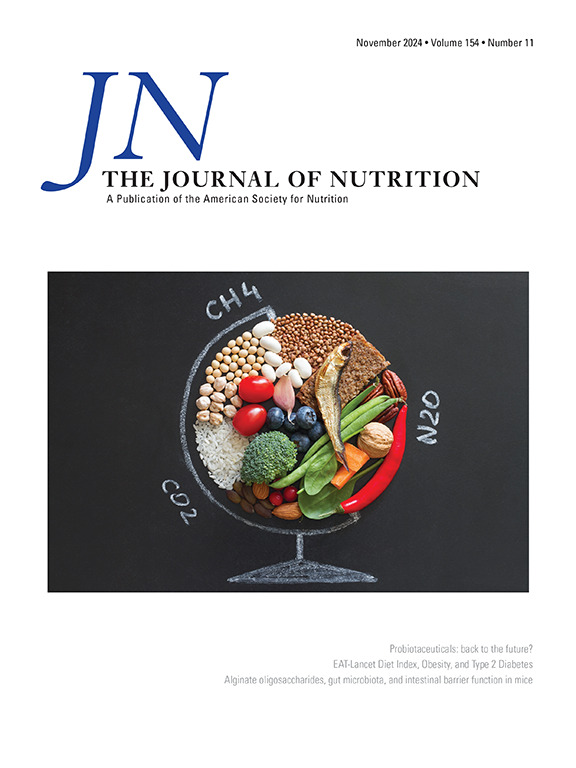孕妇孕前体重指数与肠道微生物群多样性和丰度的关系
IF 3.7
3区 医学
Q2 NUTRITION & DIETETICS
引用次数: 0
摘要
背景:了解孕前营养状况与怀孕期间肠道微生物群之间的联系可能会导致新的母婴健康干预措施。我们探讨了孕前体重指数(BMI)状态与怀孕期间肠道微生物群多样性和丰度的关系。方法:对来自印度尼西亚雅加达初级卫生中心的90名孕妇进行横断面研究。训练有素的工作人员就社会人口特征和营养摄入对妇女进行了采访,从产前记录中收集了孕前体重指数数据,并获得了粪便样本。采用16S rRNA(核糖体核糖核酸)测序分析样品的微生物群多样性指数[Shannon, Faith系统发育多样性(Faith PD)和Chao1]和丰度。在调整碳水化合物和蛋白质摄入量、种族和教育程度的同时,进行多因素logistic回归,以确定孕前BMI和α多样性指数以及厚壁菌门、普氏菌属和Blautia属存在的关系。结果:孕前超重或肥胖(BMI≥23.0 kg/m2)的孕妇肠道微生物群多样性高于Shannon指数中位数(aOR 0.4, 95% CI 0.1 ~ 0.9, p值=0.042)、Faith PD (aOR 0.2, 95% CI 0.1 ~ 0.8, p值=0.015)和Chao1 (aOR 0.3, 95% CI 0.1 ~ 0.7, p值=0.006)的几率明显低于未超重或未肥胖的孕妇。与非超重或肥胖的妇女相比,超重或肥胖的孕前妇女在厚壁菌门(aOR 0.38, 95% CI 0.15-0.98, p值=0.045)和蓝藻属(aOR 0.32, 95% CI 0.12-0.85, p值=0.022)水平高于中位数的几率也显著降低。结论:孕前超重或肥胖与城市社区孕妇肠道微生物群多样性和厚壁菌门和蓝菌门丰度较低有关。这些发现表明,孕前干预控制体重指数可能改善肠道菌群,并可能对孕妇有益。本文章由计算机程序翻译,如有差异,请以英文原文为准。
Association of Prepregnancy Body Mass Index with Gut Microbiota Diversity and Abundance in Pregnant Women
Background
Understanding the link between prepregnancy nutritional status and gut microbiota during pregnancy may lead to novel maternal and child health interventions.
Objective
To explore the association of prepregnancy body mass index (BMI) status with gut microbiota diversity and abundance during pregnancy.
Methods
A cross-sectional study was conducted on 90 pregnant women from primary health centers in Jakarta, Indonesia. Trained staff interviewed women on sociodemographic characteristics and nutrient intake, gathered data on prepregnancy BMI from antenatal records, and obtained fecal samples. Samples were analyzed for microbiota diversity indices [Shannon, Faith phylogenetic diversity (Faith PD), and Chao1] and abundance using 16S ribosome ribonucleic acid sequencing. Multivariate logistic regression was performed adjusting for carbohydrate and protein intake, ethnicity, and education to determine the relationship between prepregnancy BMI and the alpha diversity indices and the presence of the phylum Firmicutes and genera Prevotella and Blautia.
Results
Pregnant women who were overweight or obese (BMI ≥23.0 kg/m2) before pregnancy had significantly lower odds of having gut microbiota diversity above the median of the Shannon index [adjusted odds ratio (aOR): 0.37, 95% confidence interval (CI): 0.14, 0.97, P = 0.042], Faith PD (aOR: 0.23, 95% CI: 0.07, 0.75, P = 0.015), and Chao1 (aOR: 0.25, 95% CI: 0.09, 0.67, P = 0.006) compared with those who were neither overweight nor obese. Prepregnant women who were overweight or obese also had significantly lower odds of having levels above the median of the phylum Firmicutes (aOR: 0.38, 95% CI: 0.15, 0.98, P = 0.045) and genus Blautia (aOR: 0.32, 95% CI: 0.12, 0.85, P = 0.022) compared with women who were neither overweight nor obese.
Conclusions
Prepregnancy overweight or obese status was associated with lower gut microbiota diversity and lower abundance of Firmicutes and Blautia among pregnant women in an urban community. These findings suggest that prepregnancy interventions to control BMI may improve gut flora and potentially benefit pregnant women.
求助全文
通过发布文献求助,成功后即可免费获取论文全文。
去求助
来源期刊

Journal of Nutrition
医学-营养学
CiteScore
7.60
自引率
4.80%
发文量
260
审稿时长
39 days
期刊介绍:
The Journal of Nutrition (JN/J Nutr) publishes peer-reviewed original research papers covering all aspects of experimental nutrition in humans and other animal species; special articles such as reviews and biographies of prominent nutrition scientists; and issues, opinions, and commentaries on controversial issues in nutrition. Supplements are frequently published to provide extended discussion of topics of special interest.
 求助内容:
求助内容: 应助结果提醒方式:
应助结果提醒方式:


